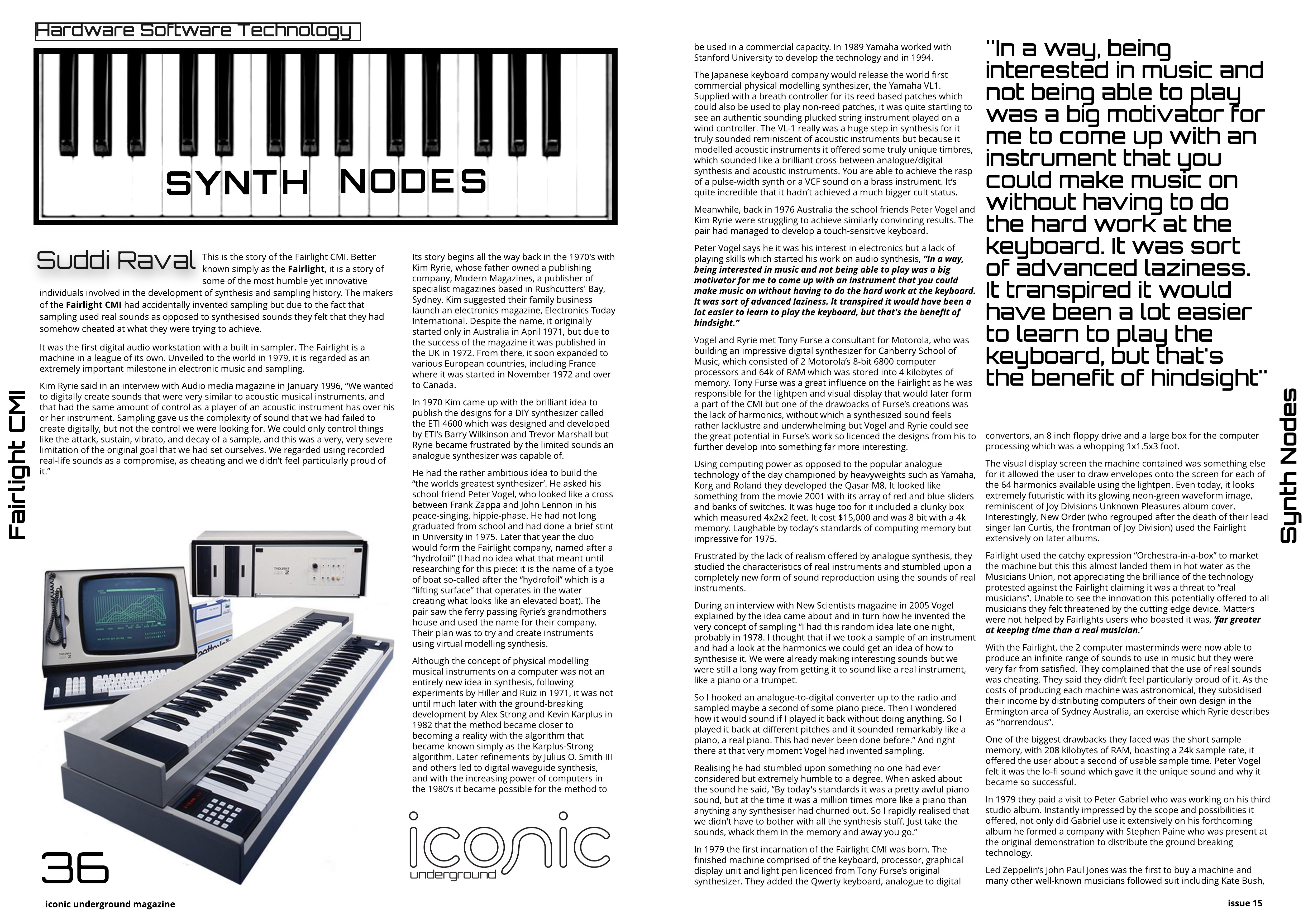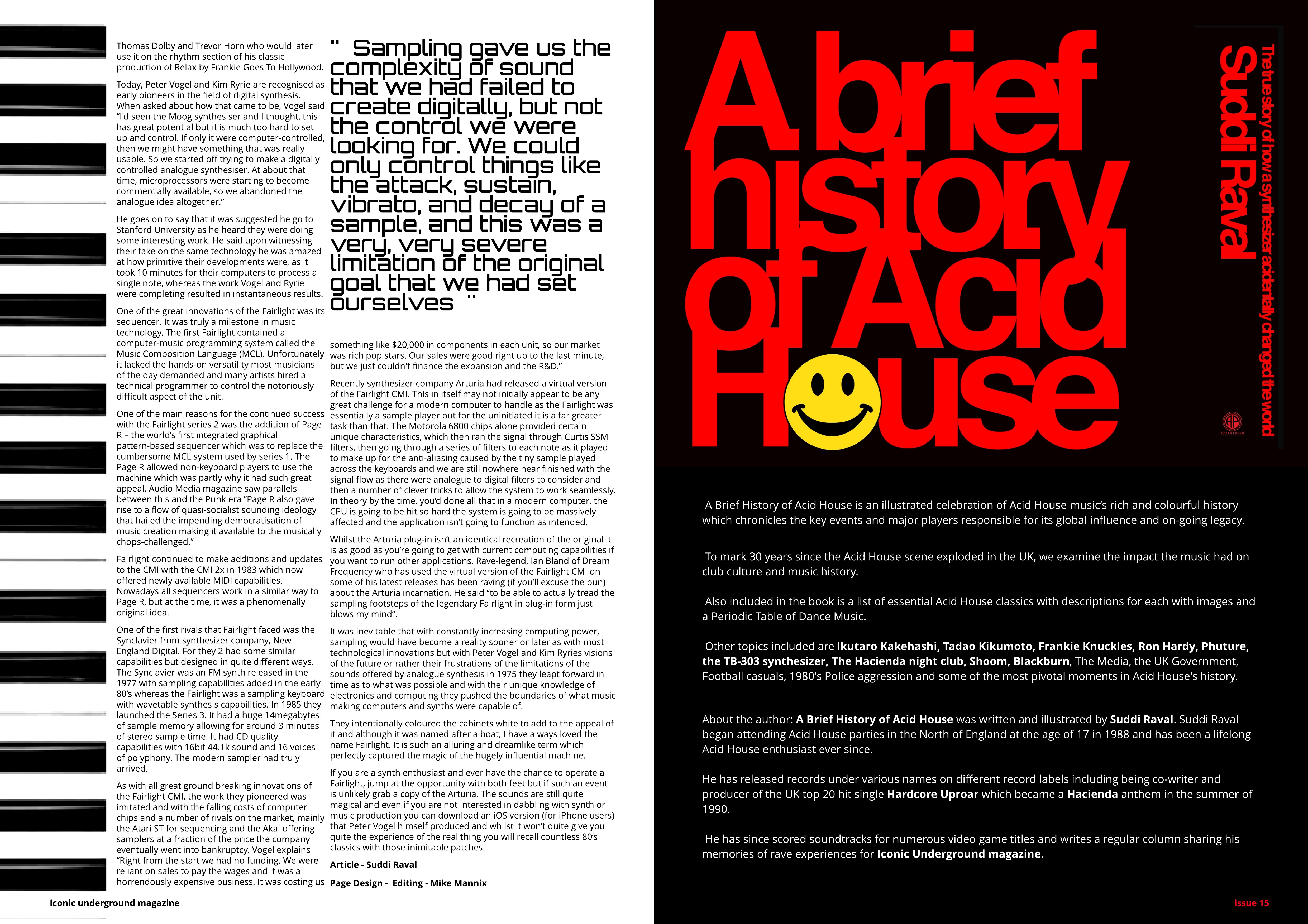
Synth Nodes – Fairlight CMI The Worlds 1st DAW & Built-In Sampler
August 16, 2019Review – Suddi Raval
This is the story of the Fairlight CMI. Better known simply as the Fairlight, it is a story of some of the most humble yet innovative individuals involved in the development of synthesis and sampling history. The makers of the Fairlight CMI had accidentally invented sampling but due to the fact that sampling used real sounds as opposed to synthesised sounds, they felt that they had somehow cheated at what they were trying to achieve.

It was the first digital audio workstation with a built-in sampler. The Fairlight is a machine in a league of its own. Unveiled to the world in 1979, it is regarded as an extremely important milestone in electronic music and sampling.
Kim Ryrie said in an interview with Audio media magazine in January 1996, “We wanted to digitally create sounds that were very similar to acoustic musical instruments, and that had the same amount of control as a player of an acoustic instrument has over his or her instrument. Sampling gave us the complexity of sound that we had failed to create digitally, but not the control we were looking for. We could only control things like the attack, sustain, vibrato, and decay of a sample, and this was a very, very severe limitation of the original goal that we had set ourselves. We regarded using recorded real-life sounds like a compromise, as cheating and we didn’t feel particularly proud of it.”
Its story begins all the way back in the 1970s with Kim Ryrie, whose father owned a publishing company, Modern Magazines, a publisher of specialist magazines based in Rushcutters’ Bay, Sydney. Kim suggested their family business launch an electronics magazine, Electronics Today International. Despite the name, it originally started only in Australia in April 1971, but due to the success of the magazine, it was published in the UK in 1972. From there, it soon expanded to various European countries, including France where it was started in November 1972 and over to Canada.
In 1970 Kim came up with the brilliant idea to publish the designs for a DIY synthesizer called the ETI 4600 which was designed and developed by ETI’s Barry Wilkinson and Trevor Marshall but Ryrie became frustrated by the limited sounds an analogue synthesizer was capable of.
He had a rather ambitious idea to build the “the worlds greatest synthesizer’. He asked his school friend Peter Vogel, who looked like a cross between Frank Zappa and John Lennon in his peace-singing, hippie-phase. He had not long graduated from school and had done a brief stint in University in 1975. Later that year the duo would form the Fairlight company, named after a “hydrofoil” (I had no idea what that meant until researching for this piece: it is the name of a type of boat so-called after the “hydrofoil” which is a “lifting surface” that operates in the water creating what looks like an elevated boat). The pair saw the ferry passing Ryrie’s grandmothers house and used the name for their company. Their plan was to try and create instruments using virtual modelling synthesis.
Although the concept of physical modelling musical instruments on a computer was not an entirely new idea in synthesis, following experiments by Hiller and Ruiz in 1971, it was not until much later with the ground-breaking development by Alex Strong and Kevin Karplus in 1982 that the method became closer to becoming a reality with the algorithm that became known simply as the Karplus-Strong algorithm. Later refinements by Julius O. Smith III and others led to digital waveguide synthesis, and with the increasing power of computers in the 1980’s, it became possible for the method to be used in a commercial capacity.
In 1989 Yamaha worked with Stanford University to develop the technology and in 1994. The Japanese keyboard company would release the world first commercial physical modelling synthesizer, the Yamaha VL1. Supplied with a breath controller for its reed-based patches which could also be used to play non-reed patches, it was quite startling to see an authentic-sounding plucked string instrument played on a wind controller.
The VL-1 really was a huge step in synthesis for it truly sounded reminiscent of acoustic instruments but because it modelled acoustic instruments it offered some truly unique timbres, which sounded like a brilliant cross between analogue/digital synthesis and acoustic instruments. You are able to achieve the rasp of a pulse-width synth or a VCF sound on a brass instrument. It’s quite incredible that it hadn’t achieved much bigger cult status.
Meanwhile, back in 1976 Australia, the school friends Peter Vogel and Kim Ryrie were struggling to achieve similarly convincing results. The pair had managed to develop a touch-sensitive keyboard.
Peter Vogel says he it was his interest in electronics but a lack of playing skills which started his work on audio synthesis,
“In a way, being interested in music and not being able to play was a big motivator for me to come up with an instrument that you could make music on without having to do the hard work at the keyboard. It was sort of advanced laziness. It transpired it would have been a lot easier to learn to play the keyboard, but that’s the benefit of hindsight.”
Vogel and Ryrie met Tony Furse a consultant for Motorola, who was building an impressive digital synthesizer for Canberra School of Music, which consisted of 2 Motorola’s 8-bit 6800 computer processors and 64k of RAM which was stored into 4 kilobytes of memory. Tony Furse was a great influence on the Fairlight as he was responsible for the lightpen and visual display that would later form a part of the CMI but one of the drawbacks of Furse’s creations was the lack of harmonics, without which a synthesized sound feels rather lacklustre and underwhelming but Vogel and Ryrie could see the great potential in Furse’s work so licenced the designs from his to further develop into something far more interesting.
Using computing power as opposed to the popular analogue technology of the day championed by heavyweights such as Yamaha, Korg and Roland they developed the Qasar M8. It looked like something from the movie 2001 with its array of red and blue sliders and banks of switches. It was huge too for it included a clunky box which measured 4x2x2 feet. It cost $15,000 and was 8 bit with a 4k memory. Laughable by today’s standards of computing memory but impressive for 1975.
Frustrated by the lack of realism offered by analogue synthesis, they studied the characteristics of real instruments and stumbled upon a completely new form of sound reproduction using the sounds of real instruments.
During an interview with New Scientists magazine in 2005, Vogel explained by the idea came about and in turn how he invented the very concept of sampling “I had this random idea late one night, probably in 1978. I thought that if we took a sample of an instrument and had a look at the harmonics we could get an idea of how to synthesise it. We were already making interesting sounds but we were still a long way from getting it to sound like a real instrument, like a piano or a trumpet.
So I hooked an analogue-to-digital converter up to the radio and sampled maybe a second of some piano piece. Then I wondered how it would sound if I played it back without doing anything. So I played it back at different pitches and it sounded remarkably like a piano, a real piano. This had never been done before.” And right there at that very moment, Vogel had invented sampling.
Realising he had stumbled upon something no one had ever considered but extremely humble to a degree. When asked about the sound he said, “By today’s standards it was a pretty awful piano sound, but at the time it was a million times more like a piano than anything any synthesiser had churned out. So I rapidly realised that we didn’t have to bother with all the synthesis stuff. Just take the sounds, whack them in the memory and away you go.”
In 1979 the first incarnation of the Fairlight CMI was born. The finished machine comprised of the keyboard, processor, graphical display unit and light pen licenced from Tony Furse’s original synthesizer. They added the Qwerty keyboard, analogue to digital convertors, an 8-inch floppy drive and a large box for the computer processing which was a whopping 1×1.5×3 foot.
The visual display screen the machine contained was something else for it allowed the user to draw envelopes onto the screen for each of the 64 harmonics available using the lightpen. Even today, it looks extremely futuristic with its glowing neon-green waveform image, reminiscent of Joy Divisions Unknown Pleasures album cover. Interestingly, New Order (who regrouped after the death of their lead singer Ian Curtis, the frontman of Joy Division) used the Fairlight extensively on later albums.
Fairlight used the catchy expression “Orchestra-in-a-box” to market the machine but this almost landed them in hot water as the Musicians Union, not appreciating the brilliance of the technology protested against the Fairlight claiming it was a threat to “real musicians”. Unable to see the innovation this potentially offered to all musicians they felt threatened by the cutting edge device. Matters were not helped by Fairlights users who boasted it was,
‘far greater at keeping time than a real musician.’
With the Fairlight, the 2 computer masterminds were now able to produce an infinite range of sounds to use in music but they were very far from satisfied. They complained that the use of real sounds was cheating. They said they didn’t feel particularly proud of it. As the costs of producing each machine were astronomical, they subsidised their income by distributing computers of their own design in the Ermington area of Sydney Australia, an exercise which Ryrie describes as “horrendous”.
One of the biggest drawbacks they faced was the short sample memory, with 208 kilobytes of RAM, boasting a 24k sample rate, it offered the user about a second of usable sample time. Peter Vogel felt it was the lo-fi sound which gave it the unique sound and why it became so successful.
In 1979 they paid a visit to Peter Gabriel who was working on his third studio album. Instantly impressed by the scope and possibilities it offered, not only did Gabriel use it extensively on the forthcoming album he formed a company with Stephen Paine who was present at the original demonstration to distribute the groundbreaking technology.
Led Zeppelin’s John Paul Jones was the first to buy a machine and many other well-known musicians followed suit including Kate Bush, Thomas Dolby and Trevor Horn who would later use it on the rhythm section of his classic production of Relax by Frankie Goes To Hollywood.
Today, Peter Vogel and Kim Ryrie are recognised as early pioneers in the field of digital synthesis. When asked about how that came to be, Vogel said “I’d seen the Moog synthesiser and I thought, this has great potential but it is much too hard to set up and control. If only it were computer-controlled, then we might have something that was really usable. So we started off trying to make a digitally controlled analogue synthesiser. At about that time, microprocessors were starting to become commercially available, so we abandoned the analogue idea altogether.”
He goes on to say that it was suggested he go to Stanford University as he heard they were doing some interesting work. He said upon witnessing their take on the same technology he was amazed at how primitive their developments were, as it took 10 minutes for their computers to process a single note, whereas the work Vogel and Ryrie were completing resulted in instantaneous results.

One of the great innovations of the Fairlight was its sequencer. It was truly a milestone in music technology. The first Fairlight contained a computer-music programming system called the Music Composition Language (MCL). Unfortunately, it lacked the hands-on versatility most musicians of the day demanded and many artists hired a technical programmer to control the notoriously difficult aspect of the unit.
One of the main reasons for the continued success with the Fairlight series 2 was the addition of Page R – the world’s first integrated graphical pattern-based sequencer which was to replace the cumbersome MCL system used by series 1. The Page R allowed non-keyboard players to use the machine which was partly why it had such great appeal. Audio Media magazine saw parallels between this and the Punk era “Page R also gave rise to a flow of quasi-socialist sounding ideology that hailed the impending democratisation of music creation making it available to the musically chops-challenged.”
Fairlight continued to make additions and updates to the CMI with the CMI 2x in 1983 which now offered newly available MIDI capabilities. Nowadays all sequencers work in a similar way to Page R, but at the time, it was a phenomenally original idea.
One of the first rivals that Fairlight faced was the Synclavier from synthesizer company, New England Digital. For they 2 had some similar capabilities but designed in quite different ways. The Synclavier was an FM synth released in 1977 with sampling capabilities added in the early ’80s whereas the Fairlight was a sampling keyboard with wavetable synthesis capabilities. In 1985 they launched the Series 3. It had a huge 14megabytes of sample memory allowing for around 3 minutes of stereo sample time. It had CD-quality capabilities with 16bit 44.1k sound and 16 voices of polyphony. The modern sampler had truly arrived.
As with all great groundbreaking innovations of the Fairlight CMI, the work they pioneered was imitated and with the falling costs of computer chips and a number of rivals on the market, mainly the Atari ST for sequencing and the Akai offering samplers at a fraction of the price the company eventually went into bankruptcy. Vogel explains “Right from the start we had no funding. We were reliant on sales to pay the wages and it was a horrendously expensive business. It was costing us something like $20,000 in components in each unit, so our market was rich pop stars. Our sales were good right up to the last minute, but we just couldn’t finance the expansion and the R&D.”
Recently synthesizer company Arturia had released a virtual version of the Fairlight CMI. This in itself may not initially appear to be any great challenge for a modern computer to handle as the Fairlight was essentially a sample player but for the uninitiated, it is a far greater task than that. The Motorola 6800 chips alone provided certain unique characteristics, which then ran the signal through Curtis SSM filters, then going through a series of filters to each note as it played to make up for the anti-aliasing caused by the tiny sample played across the keyboards and we are still nowhere near finished with the signal flow as there were analogue to digital filters to consider and then a number of clever tricks to allow the system to work seamlessly. In theory by the time, you’d done all that in a modern computer, the CPU is going to be hit so hard the system is going to be massively affected and the application isn’t going to function as intended.
Whilst the Arturia plug-in isn’t an identical recreation of the original it is as good as you’re going to get with current computing capabilities if you want to run other applications. Rave-legend, Ian Bland of Dream Frequency who has used the virtual version of the Fairlight CMI on some of his latest releases has been raving (if you’ll excuse the pun) about the Arturia incarnation. He said, “to be able to actually tread the sampling footsteps of the legendary Fairlight in plug-in form just blows my mind”.
It was inevitable that with constantly increasing computing power, sampling would have become a reality sooner or later as with most technological innovations but with Peter Vogel and Kim Ryrie’s visions of the future or rather their frustrations of the limitations of the sounds offered by analogue synthesis in 1975 they leapt forward in time as to what was possible and with their unique knowledge of electronics and computing they pushed the boundaries of what music-making computers and synths were capable of.
They intentionally coloured the cabinets white to add to the appeal of it and although it was named after a boat, I have always loved the name Fairlight. It is such an alluring and dreamlike term which perfectly captured the magic of the hugely influential machine.
If you are a synth enthusiast and ever have the chance to operate a Fairlight, jump at the opportunity with both feet but if such an event is unlikely to grab a copy of the Arturia. The sounds are still quite magical and even if you are not interested in dabbling with synth or music production you can download an iOS version (for iPhone users) that Peter Vogel himself produced and whilst it won’t quite give you quite the experience of the real thing you will recall countless 80’s classics with those inimitable patches.


